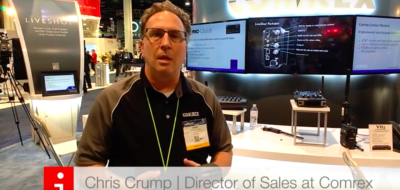By Jay Yeary

Comrex BRIC-Link II IP audio codec
In my August column, “The Audio World Without ISDN,” we looked at the impending demise of ISDN and the options available for those who can no longer get service. With telcos pushing everything into the packet-switched world, it certainly appears that any solution to this dilemma will be IP-centered.
Manufacturers of ISDN hardware and IP software obviously want us to move in that direction since they already have solutions available, and, in many instances, the hardware is designed to drop into the studio as a direct replacement for an ISDN codec.
Whether we move from ISDN to IP is no longer a question but more a matter of time, so we need to examine concerns about how to make the transition smoothly.
YOU WANT IT WHEN?
Reliability seems to be the greatest concern when it comes to using the internet to provide audio services. ISDN provides nearly rock-solid reliability with uptime the norm, not exactly how most of us would describe our experience with internet connections.
There is little we can do if the network goes offline, but choosing the most reliable provider who can deliver sufficient speed and bandwidth for our needs is the first step, though anyone in a large organization will likely have no choice in the matter.
When shopping for bandwidth, just about any modern urban internet plan will suffice because audio data is relatively small in terms of network traffic. A peek at some of the larger internet providers shows that the current slowest business-plan download speed is 10 Mbps, which is more than sufficient for receive data. However, the upload speed for that plan is just 1 Mbps, which gives no headroom for outgoing audio data if the network is performing subpar that day, so a plan with more upload speed, say 5 Mbps, makes more sense.
Anyone who wants a really robust connection has the option of leasing a dedicated network line between the provider and the studio. It is extremely important to make sure the provider doesn’t have data caps that will shut down your service if you’ve done too many sessions and exceeded your cap.
Fortunately, now that Google is expanding its fiber network, subsequently inspiring previously hesitant telcos to do the same, faster network upload and download speeds should be on the horizon for most everyone.
PACKET LOSS

A source-connect now IP audio session in progress
There are a number of technologies built into IP audio codecs to ensure they are robust enough for professional use. Remember that our audio data is being broken into packets, then sent across the internet to a specific destination where they are reassembled in order, despite the fact they may have taken vastly different paths to get there. Due to the fragmented nature of the network there is a high probability that jitter will occur because packets rarely arrive in order, but this is dealt with by introducing a buffer delay prior to reassembly.
There is also the possibility, dependent on a host of factors, that some packets won’t arrive at all, resulting in packet loss. Buffering introduces latency in the path, which can be a problem for live audio sessions; and packet loss is what everyone dreads because it means some of your audio data has gone missing. In reality neither of these are significant problems in IP audio streams because all the codecs use some form of data compression to minimize demands placed on the network while they actively manage buffers to minimize delay.
Virtually all IP codecs use Forward Error Correction (FEC), which puts duplicates of packets inside adjacent packets so the data can be reproduced even if a packet, or a string of packets, is lost.
For larger organizations there can be problems using the business LAN to send data, though the problems are not nearly as prevalent with audio as with video. It is possible to have the IT department prioritize traffic using Quality of Service (QOS) tools within the router. The bigger issue when passing media data on business LANs tends to be with firewall rules that limit traffic or close ports.
These issues can usually be handled by working with the internal IT department, but be aware that sometimes updates are pushed out and device refreshes are done by IT that may not include the changes requested for audio traffic, so it’s important that they include those changes in their base firewall and router configurations.
PRACTICAL SOLUTIONS
At the practical end of the spectrum is how these things work in everyday use. While I rarely cross paths with ISDN these days, I do spend a lot of time using IP devices for television production. I hope the following example gives some idea of how solid IP audio is.
For a weekly news show, we use two Comrex BRIC-Link II bidirectional point-to-point IP audio codecs using AAC/HE-AAC coding for IFB and backup audio, as well as two Haivision Makito video and audio units passing 1920x1080i video and MPEG-4 48 kHz audio at an average bandwidth of 6400 Kbps for all traffic.
The BRIC-Link IP audio codecs have been rock solid with no loss of audio even though data passes through two networks and myriad firewalls that hide the networks from the outside world. The Makito makes good-looking video, despite the low bit-rate. We occasionally experience blocking in the image, but never have any loss of audio.
The final choice here is whether to choose a hardware or software codec, and this decision likely comes down to what the destination connection will be. Either prefer the same or similar codec at each end though there is some flexibility and bridging is always available. For studios with control over both ends of the chain, a hardware codec may make more sense. Radio and remote television broadcasts are perfect places to use hardware codecs due to their plug-in simplicity. For voice actors and smaller studios, the choice is not so clear and software codecs may offer more flexibility. Regardless, the world without ISDN is here and everything will be fine.
Jay Yeary is a broadcast engineer and consultant who specializes in audio. He is an AES Fellow and a member of SBE, SMPTE and TAB. He can be contacted through TV Technology or at transientaudiolabs.com.
via TV Technology


